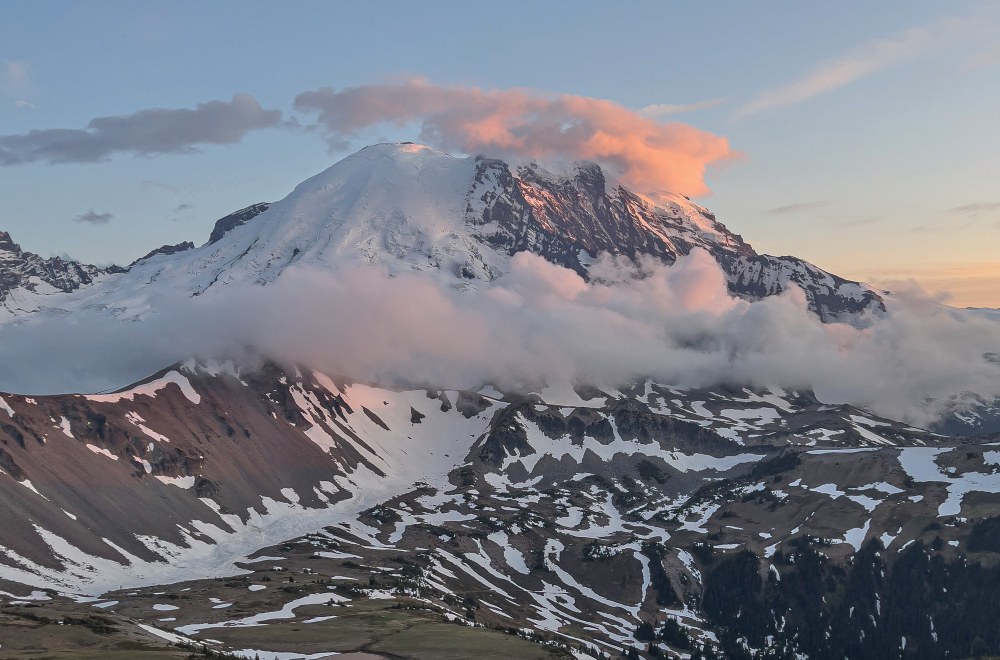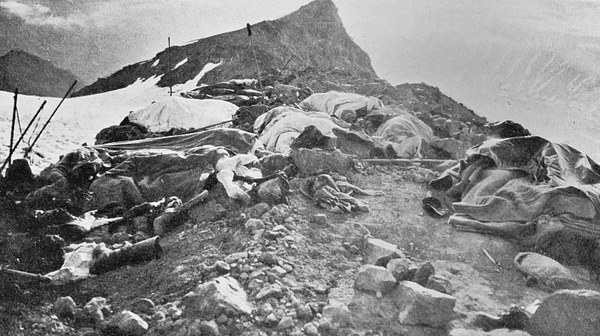
On July 29, 1909, during The Mountaineers first organized climb of Mt. Rainier, members crafted an incredible feat of mountain engineering: a 62-person bed. Huddled on a ridgeline between the Inter and Emmons Glaciers, 62 climbers built a headboard with large rocks, then dragged and compacted soil and volcanic ash to form a mattress. If that wasn’t lavish enough, many members even had a sleeping bag.
The following day, all 62 climbers successfully summited Mt. Rainier – a huge achievement for an organization only in its third year of existence. What sticks out most, though, is founding member and climb leader Asahel Curtis’ reflection after the trip: The Mountaineers must “assist in every way possible in the work of protecting the beautiful places of our state. A great part of this must be in educating those who go each year into the mountains.” Explore, learn, and conserve - values that still guide our organization today.
Not much has changed since that first trip up Mt. Rainier (although today’s ideal human-to-sleeping bag ratio is 1:1). Our community still revels in Type 2 fun. We still sleep - and find comfort - in unconventional places. And Mt. Rainier National Park is still the epicenter of our community’s mission, work, and play. As we celebrate the park’s 125 anniversary this year, let’s look back at over a century of Mountaineers exploring, learning, and conserving in America’s fifth national park.
Explore: Daring ascents and history-making at 14,000 feet
From early outings circumnavigating the mountain to daring first documented ascents, Mt. Rainier – known as Tahoma by local tribes who have maintained cultural connections to the mountain since time immemorial – has captured the hearts and minds of Mountaineers for generations. Ome Daiber probably felt this inspiration when he approached fellow Mountaineer Will Borrow Jr. about climbing Liberty Ridge in 1935. The route had never been climbed, requiring the navigation of several broken glaciers on seriously steep terrain. Falling would be fatal.
Naturally, Borrow thought his friend was joking, and expressed his desire to keep living a healthy life on flat ground. But the allure of the unclimbed route was irresistible and within a week, Daiber, Borrow, and a third climber named Arnold Campbell set out on their adventure.
The climbers navigated a steep labyrinth of crumbling, house-sized seracs, bivouacked twice (including in the summit crater rim under the Aurora Borealis), and ate sandwiches soaked with stove fuel even though the “flavor was rather powerful.” Sixty-eight hours after starting their trek in Carbon River, they arrived at Paradise Inn, already reminiscing about the climb (but probably not the stove fuel sandwiches).
In 1992, the park continued to be a bedrock of Mountaineers history when The Mountaineers put together an all-women’s climb of Mt. Rainier. Nine women - mostly in their forties and fifties - successfully summited via the Disappointment Cleaver route, carrying t-shirts that read “Almost Over the Hill, But Not Peaked Out!” The team made waves in the local climbing world, and sports pages applauded the women for summiting at their “mature” age. “In retrospect, age and gender had little to do with our success,” shared climb leader Judi Maxwell. “It was simply competence, perseverance, and the human spirit at its very best.”
 Beds at temporary camp during the 1909 summit of Mt. Rainier. Photo by Asahel Curtis.
Beds at temporary camp during the 1909 summit of Mt. Rainier. Photo by Asahel Curtis.
Learn: A new vision for climbing education
This year, I tried to gain a bit of the 1992 climbing team’s competence by taking The Mountaineers Intermediate Glacier course. Many of the important glacier safety skills were taught in Mt. Rainier National Park, including how to build and sleep in a snow cave. Through that experience, I learned valuable lessons: snow caves take about six hours to make, and it’s possible to experience the five stages of grief in a similar timeframe. I also learned – that night and throughout the course – how to safely access Washington’s highest heights. My newfound mountain competence was a product of nearly a century of Mountaineers climbing courses.
While early trips to the park focused on exploration and stewardship, Mountaineers education kicked off in the 1930s. Recognizing that more folks were heading into the mountains without proper training, Mountaineers member Wolf Bauer pitched the idea of a fundamentals of mountaineering course to the Climbing Committee. Over the next two years, Bauer - ever the go-getter - developed and led all aspects of the climbing program.
At first, the courses were taught indoors. Quickly recognizing the importance of outdoor instruction, leaders adapted curriculum to teach skills like crevasse rescue and snow camping within the Park’s boundaries. Students were even required to summit Mt. Rainier to graduate the course. Bauer was such an effective teacher - and the park’s landscape such an effective conduit for his teachings - that he led the first documented ascent of Ptarmigan Ridge on Mt. Rainier with a group of his students in 1935.
Thanks to the management of Mt. Rainier National Park, Bauer and The Mountaineers had access to the ideal teaching space to fulfill his vision. That relationship between the park and The Mountaineers carries on today – many of our most popular courses take place in Rainier – but Bauer’s teaching environment, and the park at large, would not exist as it does today without over a century of Mountaineers work to protect it.
Conserve: How Mountaineers built and protected America's fifth oldest park
After Asahel Curtis and 61 Mountaineers summited Mt. Rainier, they returned home with an eye on their next adventure: a backpacking trip around the entire mountain. Today, that’d be a long yet straightforward trip on the Wonderland Trail. But in 1909, a round-the-mountain trail was no more than an idea.
Over the next five years, several small teams scouted the possibility of such a trail, bushwhacking through rugged terrain, mapping potential routes, and sharing suggestions for trail construction with Mt. Rainier National Park rangers who were already working on a loop. Fortunately, the Park Service decided to expedite trail work to meet The Mountaineers vision. And so, in 1915, 89 Mountaineers became the first hikers to walk the newly constructed Wonderland Trail. Now, the entirety of the park — massive glaciers, ancient forests, and soul-expanding views — was more accessible to the public.
Pieces of The Mountaineers conservation legacy can be found nearly anywhere in the park. We fought for expanded road access, blocked a plan to build a tramway from Paradise to Camp Muir, and successfully lobbied Congress to designate the park as wilderness. We’ve dedicated countless hours to stewarding the park, from early 1900s trail-building work parties to modern volunteer programs like Meadow Rovers. And we’re still advocating for the park today to ensure this beloved landscape is conserved for another 125 years and beyond.
So, the next time you’re cruising down from Camp Muir or wandering the alpine meadows of the Wonderland Trail, take a moment to think of those Mountaineers who shaped this iconic National Park into what it is today, and consider getting involved in efforts to keep the park an accessible, beautiful, and protected place for future generations to enjoy.
For more information on how to volunteer with Mount Rainier National Park, visit nps.gov/mora/getinvolved/volunteer.htm.
This article originally appeared in our fall 2024 issue of Mountaineer magazine. To view the original article in magazine form and read more stories from our publication, visit our magazine archive.
 Nathaniel Rees
Nathaniel Rees